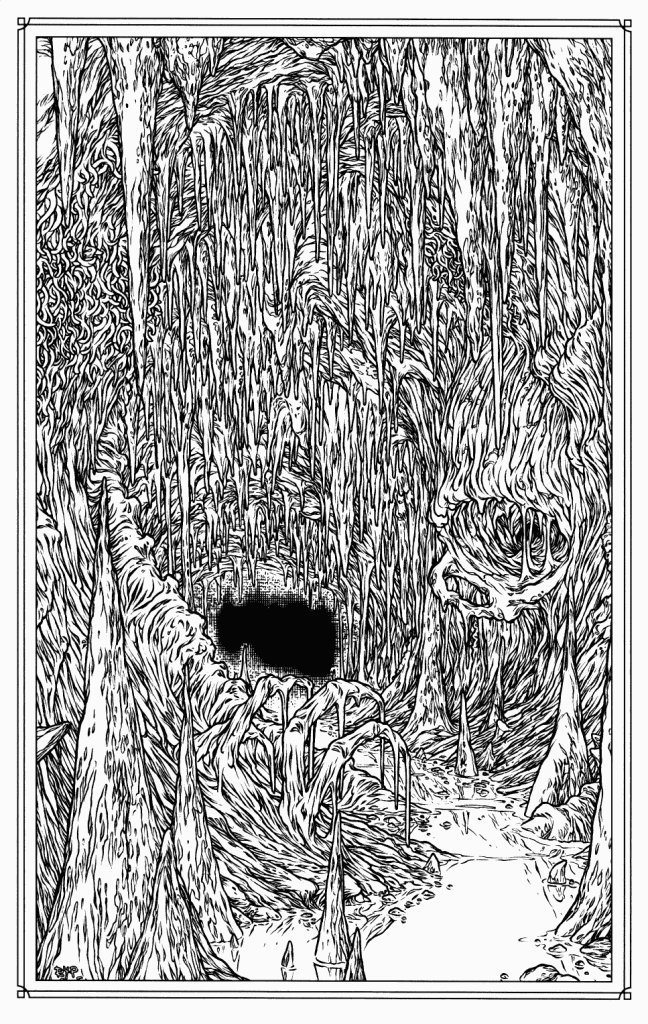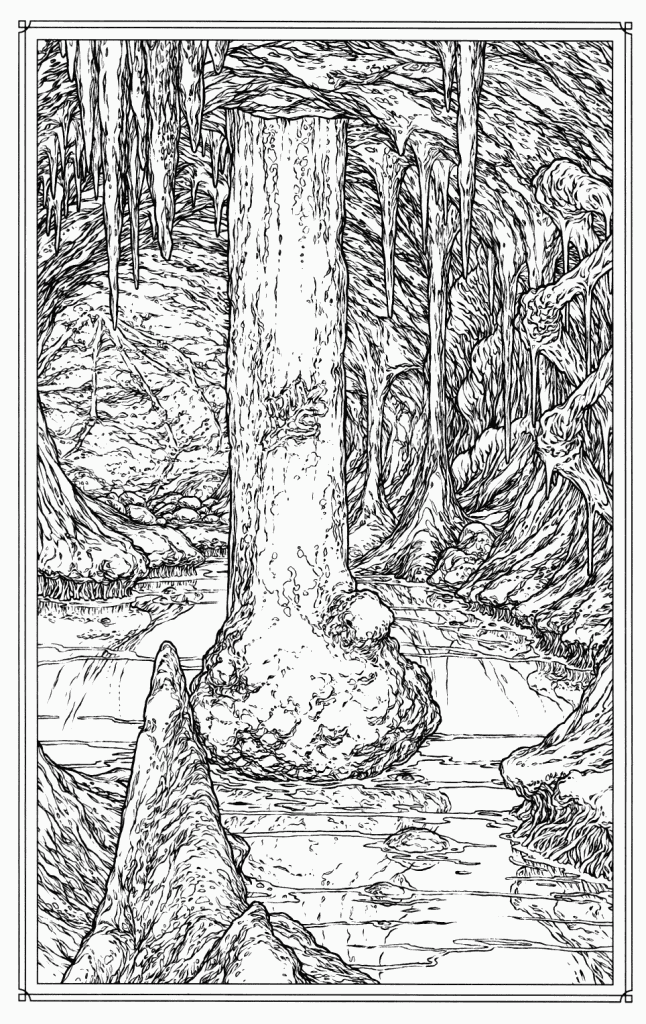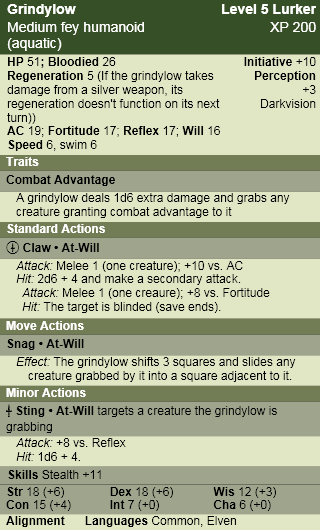Posts Tagged ‘D&D’
Tribute to Jim Roslof (1946-2011)
March 24, 2011Old-school D&D artist Jim Roslof passed away last weekend, and given the influence early D&D art has had on my predilections, I would be negligent if I didn’t join other bloggers in paying tribute.
Wizards of the Coast have put together a thoughtful collection of memories and comments from Roslof’s friends and colleagues that is worth reading. In particular, they draw attention to his work as TSR’s art director, during which time he assembled the artistic super-team of Caldwell, Easley, Elmore, Holloway, Parkinson, and Truman. It’s an interesting story, but I’m going to focus on his work as an artist.
I have to admit up front that Roslof wasn’t my favorite artist growing up. I didn’t dislike his work, but Roslof wasn’t a name that I made a point of learning (yes, D&D artists were the first artists whose names I bothered to learn). It could have been because he often didn’t sign his works (making it harder to associate a name with him), or that his style wasn’t as immediately recognizable as an Otus or Elmore, or even that he wasn’t an artist my older brothers (who introduced me to D&D) drew my attention to. But in researching this post, going back over all the illustrations Roslof contributed to D&D products over the years, I noticed how many I remembered but had not attributed to him. When I think of D&D, it is many of Roslof’s images, still lodged in the deep recesses of my gray matter, that call out for reflection.
James Maliszewski at Grognardia has an excellent post on Roslof’s TSR cover paintings (including, in an earlier post, the iconic cover to The Keep on the Borderlands), and Mortellan at Greyhawkery showcases Roslof’s epic Thor vs. the midgard serpent illustration. Those are great pictures, but instead I wanted to focus on Roslof’s numerous black and white interior spot illustrations. These are just the kind of pictures that I mentioned earlier. They probably aren’t the illustrations that come to mind as people’s favorite, but they are immediately recognizable, and represent the visual building blocks that make up D&D.
I present in chronological order the illustrations of Jim Roslof (as usual click on the image to see it full size).
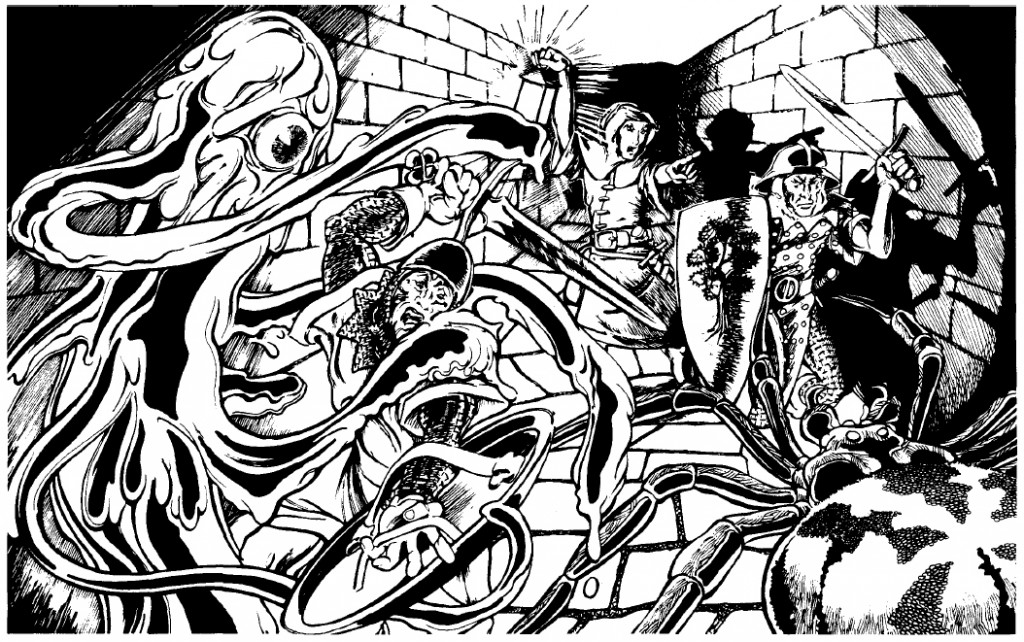
Roslof is well known for his cover painting of Queen of the Demonweb Pits, but he also did interior illustrations for the module as well, including this one depicting a yochlol and spider attacking a party of warriors. The thing I like about this picture is the focus on the party’s light source. Not only does it instantly tell the story of D&D (bringing light into the dark, unknown depths where horrible things live), it’s also a good example of game play (light sources and their durations being especially important in early D&D).
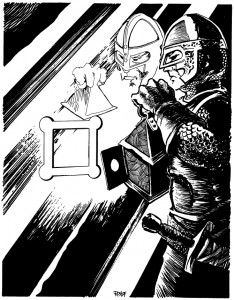
The next picture is one of my favorites that I found, although I have a hard time articulating why. It could be because The Ghost Tower of Inverness (which Roslof also painted the cover for), was one of the modules my older brother owned, and years of pouring through that booklet adds weight to all the pictures held within. It could be the play of light and shadow again. Or it could just be that the fighter pictured looks like the kind of hard bitten bad ass you wanted your character to be. He might not be superhumanly strong, but the set of his jaw, and the careful way he’s inspecting that door, give you the impression he’s seen his share of danger and bloodshed. Maybe I’m reading too much into this drawing, but I’ve always associated this guy with Nick Fury.
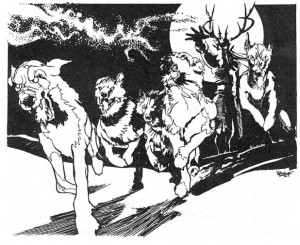
Roslof may have done all the illustrations for the Greek pantheon in Deities and Demigods, but since my mind had already been colonized by the Hercules cartoon those aren’t the images that stick with me – it’s his depiction of the master of the wild hunt unleashing his hounds. Everything works in this picture: the full moon, the sinister face hidden by shadow, the movement of the dogs. Just like the folk tales, when you see that on the horizon you don’t pull our your sword +1/+3 vs. shapeshifters (I don’t know why I choose that sword – I guess I always found it funny), you turn tail and run. Which, incidentally, is exactly what I did when I encountered him in an uber high level adventure a friend made for me in public school (well my characters didn’t run, they jetted away on flying carpets – uber high level remember).
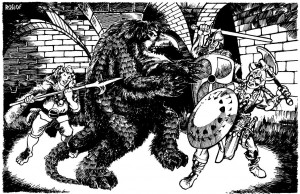
As I mentioned, Roslof is most well known for the cover of The Keep on the Borderlands, but this illustration of a party attacking an owlbear graced the cover page of that module. For me this has always been the iconic image of the owlbear (I do like what Paizo did with the creature for their Kingmaker adventure path), and even though I’ve stared at this picture thousands of times, it wasn’t until today that I realized the fellow gleefully getting ready to stick the monster with his bill-hook is a halfling. I guess I was always focused on the creature (its about to rip that shield away and gut that barbarian with its razor sharp beak – or so I’ve always thought).
![]()
Finally, I wanted to mention the module Baltron’s Beacon. Not my favorite adventure (that may be because I’ve never actually played through it and hadn’t even seen it until the nineties), but its worth noting because it’s the only book where Roslof has the sole interior art credit. The illustrations are great in this module, especially the player handouts (like they did with Tomb of Horrors and Expedition to the Barrier Peaks). I wanted to end with Roslof’s only two-page spread, depicting a party fighting a group of undead lizard men. As far as I know it’s the first picture of its type that TSR published. Is Jim Roslof responsible for pioneering the ‘wall of action’ style of fantasy illustration? Who knows? But I can easily imagine this picture catching the eye of a young Wayne Reynolds when it was published in 1985.
As a post script I should also mention that I’m incredibly jealous of Jim Roslof’s cool signature. Not the coolest signature in the world (that honor goes to Bill Willingham), but infinitely hipper than my own.
The Pool of the Black One – Part One
March 19, 2011The Pool of the Black One is Howard’s first pirate themed Conan yarn (although Conan’s past as a pirate was hinted at in The Scarlet Citadel) and establishes the rivalry between the Zingaran freebooters and the Barachan pirates. It’s also a fun blending of weird fantasy and grimy, pirate adventure – an indispensable read for anyone who’s a fan of Green Ronin’s Freeport series of adventures.
Once again though, the female character is problematic and I think I’ve finally put my finger on what bothers me about Sancha (and Natala for that matter). It’s not the ownership of women (Howard uses slavery as one of his criticisms of ‘civilization’), or that every women jumps into Conan’s bed by the end (which intimates that the only currency women have is their bodies – but this is a well established pulp adventure trope that’s continued into the action movies of today so I can hardly single Howard out for that). What bothers me is when Howard’s female characters lack any agency, any way of impacting events in the world for themselves without attaching themselves to another character. Not all his female protagonists are like that, I guess with the last two stories in a row it was just getting to me a little.
Spoiler Alert! All of these Hyborian age posts are going to be filled with spoilers. From the summary, to the monster stats they are going to ruin any surprises as to what the monster is, when they pop up in the story and how and why they are killed. You’ve been warned.
Summary
The story begins with Conan fleeing the Barachan Isles on a leaking rowboat, and then making a swim for the first ship he sees – the Wastrel, captained by the freebooter Zaporavo. There is a tense moment between the men while the captain decides what to do with the Cimmerian. Ultimately, he chooses to let Conan join the crew instead of ordering his men to cut him down. This sets into motion a series of events that will see Zaporavo lose “his ship, his command, his girl, and his life.”
After a failed hazing from the rest of the crew that leaves the offender with a snapped neck, Conan soon earns their respect with his skill as a sailor and his prodigious strength. He also attracts the eye of Zaporavo’s concubine, Sancha.
Following clues left in the legendary scrolls of Skelos, Zaporavo heads into the uncharted west, in search of a forgotten civilization and its ancient treasures. Eventually the Wastrel reaches the forgotten island and Zaporavo orders his crew to stay near the shore and gather supplies while he searches the interior alone. Conan slips into the trees after the captain, bloody business on his mind, while the rest of the crew gorges on strange, golden fruit.
Conan soon reaches his quarry, and away from the prying eyes of the crew, duels Zaporavo for the Wastrel. After slaying the Zingaran, Conan continues inland, his curiosity piqued at his former captain’s quest for treasure. There he finds a strange city peopled by tall, mute, dark skinned creatures with diabolical features. From his hiding place he sees the creatures torture the Wastrel’s cabin boy and use a magical green pool to transmute him into a tiny, petrified statue.
While Conan weighs his options, he sees that the creatures have captured Sancha, as well as the rest of the crew, who are in a drugged stupor from eating the island’s fruit. The Cimmerian draws his blade and dives into combat, buying the rest of the freebooters enough time to get to their feet and for Sancha to get them their weap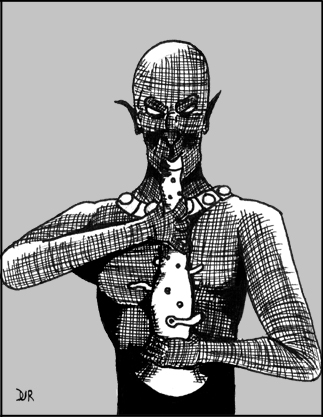 ons (I guess she isn’t completely helpless). A viscous melee follows, with losses on both sides, but the invaders have the advantage of numbers, and the dark skinned giants rout.
ons (I guess she isn’t completely helpless). A viscous melee follows, with losses on both sides, but the invaders have the advantage of numbers, and the dark skinned giants rout.
Cornered in front of the pool, the leader of the creatures breaks his silence in a howl of pure hatred and sacrifices himself into the mystic green waters. The pool erupts in a volcanic geyser, unleashing a sentient wave of death in the freebooters’ direction. Grabbing Sancha, Conan and the rest of the crew make a run for the shore, barely escaping the eerie green river chasing them.
Though ragged and bereft of any bounty, Conan has won the affections of Sancha, the Wastrel and a crew eager for the plunder of more populated waters.
Black Ones
“These creatures were black and naked, made like men, but the least of them, standing upright, would have towered head and shoulders above the tall pirate. They were rangy rather than massive, but were finely formed, with no suggestion of deformity or abnormality, save as their great height was abnormal. But even at that distance Conan sensed the basic diabolism of their features.” – Robert E. Howard, The Pool of the Black One.
Nature DC 15: The creatures known as the black ones are the result of a divergent offshoot of evolution, one that branched from humanity in the dim days of prehistory. There is a marked diabolical influence in their features, and it may be that the black ones are the result of infernal tampering, many ages before the creation of the Tiefling bloodline.
The black ones live in open air cities with glass-like walls, where they enact foul rituals and pursue strange pleasures in the name of their perverse religion. It is said these cities hold ancient knowledge and treasure for those brave enough to risk the black ones’ wrath.
Nature DC 20: The black ones have no spoken language and communicate with one another telepathically. Although it is possible for them to speak with other creatures in this manner, their disdain for all other intelligent life makes the idea repulsive to them. Legend holds that the leaders of the black ones are capable of vocalizing their hatred in an obscene howl that can blast their enemies.
Encounters
It is extremely rare to find the black ones cooperating with other intelligent races. They are xenophobic, whose only contact with other humanoids is to capture victims to sacrifice in infernal rituals. However, these rituals often bind assassin imps, spined devils, and pain devils into service. Though the concept of a pet is alien to them, the black ones have been known to use behemoths as living weapons when the need arises.
Black ones guard their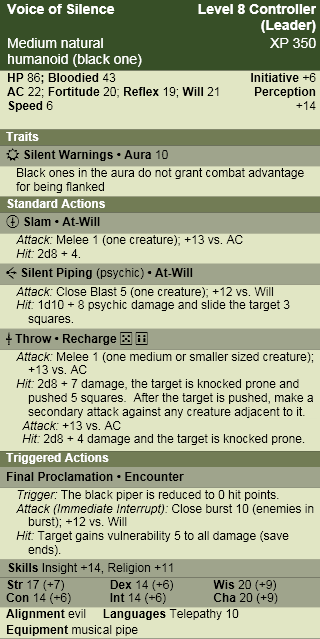 cities with magical traps and hazards, which often feature prominently in their religious practices and blasphemous entertainment.
cities with magical traps and hazards, which often feature prominently in their religious practices and blasphemous entertainment.
Black One Thug
“Conan knew that if he fell foul of that mass of taloned muscle and bone, there could be but one culmination. Once let them drag him down among them where they could reach him with their talons and use their greater body-weight to advantage, even his primitive ferocity would not prevail.” – Robert E. Howard, The Pool of the Black One.
Black One Thugs in Combat
Though they may appear as naked savages to the civilized eye, black one thugs are calm and collected in combat. They have no need for armor or weapons, their own bodies being sufficient to deal with the threats of their environment. When attacking, thugs select the most dangerous adversary in a group, surround, drag them to the ground, and mercilessly stomp the life out of them. Weaker foes are left alive to be captured for sacrifice and loathsome amusements.
Voice of Silence
“One, squatting on his haunches before the cringing boy, held a pipe-like thing in his hand. This he set to his lips, and apparently blew, though Conan heard no sound. But the Zingaran youth heard or felt, and cringed. He quivered and writhed in agony; a regularity became evident in the twitching of his limbs, which quickly became rhythmic.” – Robert E. Howard, The Pool of the Black One.
Voice of Silence in Combat
The voice of silence is the spiritual leader of a community of black ones, presiding over the diabolic rituals around which their strange cities are organized. They focus their mental powers through their pipes, which transmit thought waves instead of sound, and can force the weak willed to dance and jig like a puppet on a string. The voice of silence uses this power in combat to force foes into dangerous hazards and isolate powerful individuals for gangs of black one thugs to overpower.
Notes:
Combined with a hazard or trap (coming soon in part 2) I think that the voice of silence and a group of black one thugs would make a good encounter. Theoretically all sorts of black ones could be created for an extended adventure into one of their cities – a fast skirmisher that can drag off captives (as happened to Sancha), or even an artillery that hurls chunks of broken glass that shatter on impact (that’s not in the story, but I think it fits and it sounds cool).
When I started this project I had intended to use the chronology of the stories as a guide to assigning levels to these creatures (and I’ll still keep that in mind), but that doesn’t always translate well into the game. Most accounts put The Pool of the Black One fairly late in Conan’s career, but the piratical adventure just didn’t seem like paragon tier material to me, so I kept it to the high heroic level. For a paragon version of these creatures I would probably (in addition to upping the damage and attack bonus) add slow (save ends) to the silent piping, daze (for 1 round) to the throw, and a bonus to damage for the thugs if more than two of them are adjacent to a character (like gnolls).
H.P. Lovecraft, Allan Moore and the Underdark
March 2, 2011I’m pretty late to the game when it comes to Yuggoth Cultures and Other Growths, by Allan Moore. It was released as a three issue comic in 2003 by Avatar Press, and I remember seeing it in the comic stores at the time, thinking it looked very cool, and then promptly forgot all about it. The issues were collected together and released as a trade paperback in 2006, and yet again I missed out. It wasn’t until last week that I stumbled onto a reference to the comic and so I finally checked it out.
The title is a allusion to H.P. Lovecraft’s Fungi from Yuggoth, his collection of 36 sonnets (I know Lovecraft has deific status amongst gamers and can do no wrong, but to tell you the truth I’m not really a big fan of his sonnets and poetry). Moore imagined himself as taking cuttings from those fungi (stealing ideas here and there if you will – but there’s no shame in that), and culturing them to see what could be grown. It’s a great metaphor, and in general it works. It reminded me of a concept album in comic book form – you might not like every song on the record, but you dig where the band was going with it.
Just check Juan Jose Ryp’s wraparound cover (click on it for the full size)! The frenetic action, crazy colors and hyper detail are perfect for the madness inducing subject matter (I see Cthulhu, Nyarlathotep, a gug, a pack of ghouls, a flying polyp, and of course mi-go). As ideal as that picture is for a blog about monsters, it’s not the piece I wanted to write about.
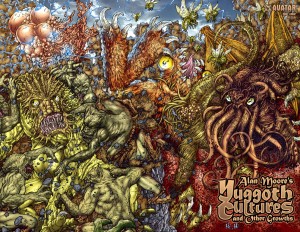
In the same issue Ryp also illustrates Moore’s poem, Zaman’s Hill, with two pieces that are the perfect representation of the underdark, maybe even the platonic ideal of the underdark (of which all other underdarks are shadows). My penchant for hyperbole aside, when I flipped to this page I was immediately struck by the thought, ‘so that’s what the underdark looks like’ (click on the pictures to see for yourself). And that’s a bit odd, since 25 years of D&D illustrations haven’t made me think that. Considering that the underdark plays such a huge role in the imagination of D&D, there are very few visual representations of it (there are many pictures of the creatures that live there though). That’s probably because there just aren’t that many landscapes in D&D illustration in general (even though Larry Elmore was clearly a master of the style). And that makes sense. Monsters are just more interesting (I am obsessed with them) and more immediate then the places which spawn them. But a great picture can transcend that generalization and I think that Ryp’s does.
In the D&D game I currently play in, my character the Jack of Clubs and his companions are working their way through a 4e adaptation of The Night Below boxed set. We’ve fought all manner of subterranean beasts (troglodytes, trolls, grell, and a behir) and I’ve never had trouble playing out those epic struggles in my mind. But when it comes to the underdark itself I feel as though my mind’s eye has formed only a crude backdrop against which our adventures play out. These pictures have changed that. My imagination is already filling those unsettling caverns with chanting Troglodytes, the maddening psionic hum of illithid mind-song, and the glittering trails of abolethic mucous chariots. The next time someone in your game wants to know what the underdark looks like, you have your answer.
But that’s not all. Yuggoth Cultures made me realize that the fungi’s spores are still spreading, sending out shoots and occasionally, twisting back together. Many of Lovecraft’s ideas are so pervasive in popular culture they sometimes come about full circle to meet each other face to face. Way back in Dragon 324 (when you could still hold the magazine in your hands) James Jacobs had a great article on Lovecraft’s influence on D&D where he specifically mentions the Lovecraftian influence on the creation of the underdark… and that’s how a pair of pictures in a comic completely unrelated to D&D come to perfectly represent one of the game’s greatest locales. Two mutant growths, sired from the same rhizome, but cultured in entirely different mediums, turn out to be twins.
The Slithering Shadow
February 24, 2011The Slithering Shadow features many elements that became synonymous with weird fantasy and were later incorporated into D&D: radiant gems, cultures that are near extinct thanks to their own decadence (the yuan-ti, kopru and bullywugs come to mind), and horrible monsters worshipped as gods. In fact, almost everything from the module B4 The Lost City is taken directly from this story (the desert, the adventure hook, the drug use and even the monster at the end). For these reasons the story is worth reading (and is exceedingly readable), there was just one thing that irked me – Natala, the female protagonist. Even more than the last story (where Yasmela is at least a capable ruler), Natala is a one dimensional damsel in distress. I don’t think the character ruins the story, but it’s unfortunate, since I know Howard is a better writer than that.
One last thing, I’m not really sure what ‘cosmic lust’ is, but the line is used in this story and has forever been linked to The Slithering Shadow’s monster… and just might be the inspiration for countless Japanese hentai movies.
Spoiler Alert! All of these Hyborian age posts are going to be filled with spoilers. From the summary, to the monster stats they are going to ruin any surprises as to what the monster is, when they pop up in the story and how and why they are killed. You’ve been warned.
Summary
This story takes place sometime in the middle of Conan’s career, during his tenure as a mercenary, probably after the events in Black Colossus.
Conan and Natala, a Brythunian Conan had rescued from a raided Shemitish slave market, find themselves without food and water, lost in the deserts east of Stygia. The pair are all that remains of a failed invasion of Stygia by Almuric, a rebel prince of Koth. With no hope of survival, Conan prepares to spare Natala an agonizing death by dehydration with a merciful sword stroke, but his hand is stayed by the image of a city in the distance.
The strange city is constructed from an eerie, green, glass-like material, and the main gates have been left unlocked. Inside, Natala and Conan find a guard who appears to be dead, but rouses from his torpor and attacks. Conan slays the madman, but the expected alarm isn’t raised, and no one else seems to be about on the city streets.
More exploration reveals other oddities, as well as the beautiful Stygian, Thalis. The stranger takes a liking to Conan, and enlightens the refugees over a meal. An outsider, Thalis came to the city of Xuthal as a child, and learned the city’s strange ways. Xuthal was founded by people from the east, learned philosophers whose science is able to produce food without farms, and radium gems whose touch brings lig ht to a room. But generations of leisure have led the culture to stagnate in decadence. The citizens spend most of their days and nights in a drug induced haze. They worship a horrible monster, Thog, who lives in the catacombs beneath the city and rises to feed on its sleeping inhabitants. That Xuthal’s people would accept death so fatalistically outrages Conan.
ht to a room. But generations of leisure have led the culture to stagnate in decadence. The citizens spend most of their days and nights in a drug induced haze. They worship a horrible monster, Thog, who lives in the catacombs beneath the city and rises to feed on its sleeping inhabitants. That Xuthal’s people would accept death so fatalistically outrages Conan.
Thalis desires Conan to stay, for she sees in the barbarian both a lover and a powerful tool for Xuthal’s conquest. Only the presence of Natala stands in the Stygian’s way, so Thalis kidnaps her and flees to the tunnels underneath the city via a secret passage.
Instead of leaving the bound Natala for Thog, Thalis decides to torture her captive as revenge for the wounds she suffered during the struggle.
Meanwhile, Conan works his way through the maze-like rooms and corridors of Xuthal, fighting with the roused inhabitants on the way.
By the time Conan reaches the catacombs, Thog has already devoured Thalis and is about to take his companion as well. Fearlessly, the barbarian launches into the monster, driving it away from Natala. The brutal battle sends a wounded Thog fleeing to the deepest reaches of the earth and leaves Conan beaten, torn and poisoned.
Together, Conan and Natala stumble their way into a quiet part of the city were the Brythunian is able to administer a stolen draught of golden elixir that purges the beast’s venom from Conan’s body.
Thog of Xuthal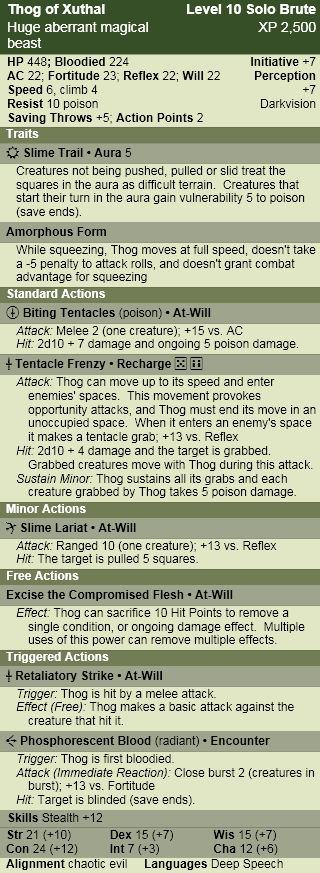
“It towered above him like a clinging black cloud. It seemed to flow about him in almost liquid waves, to envelop and engulf him… The thing seemed to be biting, clawing crushing, and clubbing him all at the same time. He felt fangs and talons rend his flesh; flabby cables that were yet hard as iron encircled his limbs and body, and worse than all, something like a whip of scorpions… tearing the skin and filling his veins with a poison that was like liquid fire.” – Robert E. Howard, The Slithering Shadow
Lore
Dungeoneering DC 20: In a sunken dome in the center of the legendary city of Xuthal, the monster known as Thog slumbers and is worshipped by the degenerate inhabitants as a god. The creature is so old that none can remember if it was brought to Xuthal by the city’s founders, or whether they unearthed it during the city’s construction.
Thog wakes at irregular intervals and stalks the secret corridors and catacombs of Xuthal, feeding on the sleeping inhabitants, who are content to await their doom in lotus dreams.
Thog of Xuthal in Combat
Thog is primarily motivated by hunger, and its preference for feeding on intelligent humanoids seems to suggest the creature needs more than just material nourishment to sustain its alien life. It attacks directly and fiercely, having lived so long it has forgotten the concept of death. In the unlikely event that Thog is gravely injured, it will retreat to its lair, where it is said there lies a well so deep it pierces the heart of the underdark.
Encounters
Thog spends much of its time in slumber, perhaps joining with its followers in one of the dream worlds the culture is so preoccupied with. Despite the creature’s predation, and even though they fear their god to the point of madness, the warriors of Xuthal protect the dome where the creature lairs and react violently to any incursion into the city from outsiders.
When hungry, Thog hunts alone, though creatures it shares a kinship with, like oozes and carrion crawlers, sometimes bubble up from the well in its lair and follow in Thog’s wake.
Notes:
My first solo monster! Many of the monsters Conan fights are solitary, but for some reason it seamed particularly appropriate for Thog to be a solo, especially given Howard’s description of it as “an aggregation of lethal creatures” (which mechanically is exactly what a solo creature is). I made it a level 10 challenge because I thought the monstrous god of a half-ruined city would be the perfect capstone to a series of heroic tier adventures.
I have to admit that creating a solo creature was difficult. Since each solo represents the xp of 5 normal creatures, there’s a lot expected out of a solo monster. I tried to follow Sly Flourish’s recommendations in ‘4 things every solo monster should have’, which I think is good advice, but may be a little heavy handed with the status effect protection. It’s true that a single daze or stun has a much greater impact on a solo encounter then it would in any other encounter, and could make a challenging fight into an unmemorable cakewalk, but take away these effects too indiscriminately and players will feel ripped off. What’s more, they’ll stop choosing those powers in favor of simple damage attacks, which also leads to boring combats (and nobody wants that). That’s why I chose to use the mechanic that I did. Challenge ruining effects can be ended, but at a cost (and only on the monster’s turn), and one I feel doesn’t leave the players feeling cheated. For the record I also think that Sly Flourish’s example is a good one, it’s just hard to apply some of the things he used to my case since he was working with an epic level monstrosity while I was looking to create a heroic challenge.
The Goblin
February 18, 2011 Goblins are weak pathetic creatures that spend most of their short lives throwing themselves onto adventurers’ swords. It’s hard to argue with that, especially since goblins have always occupied the lowest rung of the monster ladder (just a smidge above kobolds) across all editions of Dungeons and Dragons (and given the influence of D&D, many other rpgs and computer games as well). Take a look at David Trampier’s goblin from the 1e Monster Manual. Don’t get me wrong, I like this picture (especially that clean pen and ink style of his), and the goblin seems a little threatening, but his facial expression almost makes him look worried – and he should be, he’s about to be magic missiled to death. After about third level, goblins become a joke. So much so, it’s even used to comic effect in Neverwinter Nights: Hordes of the Underdark (the joke being that you have to be reminded that to your average zero level schmoe, a goblin is still dangerous).
Goblins are weak pathetic creatures that spend most of their short lives throwing themselves onto adventurers’ swords. It’s hard to argue with that, especially since goblins have always occupied the lowest rung of the monster ladder (just a smidge above kobolds) across all editions of Dungeons and Dragons (and given the influence of D&D, many other rpgs and computer games as well). Take a look at David Trampier’s goblin from the 1e Monster Manual. Don’t get me wrong, I like this picture (especially that clean pen and ink style of his), and the goblin seems a little threatening, but his facial expression almost makes him look worried – and he should be, he’s about to be magic missiled to death. After about third level, goblins become a joke. So much so, it’s even used to comic effect in Neverwinter Nights: Hordes of the Underdark (the joke being that you have to be reminded that to your average zero level schmoe, a goblin is still dangerous).
Trampier’s goblin is good art, but it isn’t great art. For me, great art in an rpg has to either completely inspire you (sometimes suggesting an idea, or a snippet of a narrative that compels you to fill in the blanks), or blow your mind open to a new possibility. Incredibly enough, there is a picture of a goblin that does just that. Back during the 2e days, when my friend and I encountered the picture below (click on it to see it in its full glory!), it totally changed what we thought goblins could be in the game. It wasn’t a picture of a goblin, it quickly became the goblin.
A little history. I first encountered Sam Rakeland’s painting in 2e’s The Complete Book of Humanoids (although it was first used for basic D&D’s module cover, Assault on Raven’s Ruin). I have a lot of love for this book. Back in the day, using its rules, I played a misguided lawful good minotaur, my friend played an alaghi druid, and we even ran an adventure where everyone was a mongrelman living in the sewer. None of us ever played a goblin, but that picture made us fear them again.
All grown up (relatively), there’s a lot I could say about why I like this painting: the use of oils gives it a nice tactile quality, the dynamic pose directly threatens the viewer, the colors suggest the kind of cold, dark, hard bitten cave life I imagine goblins to have… but that’s academic. The savage ferocity of the creature made an immediate and indelible impression on my teenage self. It reminded me that goblins were monsters, not just 1-1 HD things that could inflict 1-6 hit points of damage. I mean look at that thing, I think your name level paladin just cowered behind his shield and crapped in his armor… from a goblin! It made such an impression, that any time we fought goblins afterward; we always wanted to know if we were tackling any old goblin, or the goblin. We never did fight the goblin, but I can’t say my characters really regretted that.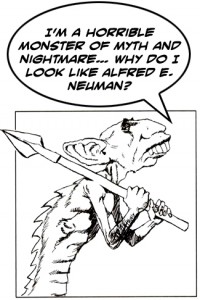
Looking at the digital paintings that grace the electronic pages of Dragon and Dungeon now, I wonder if there’s any room in D&D for this kind of illustration anymore. These days, art directors are very concerned with maintaining a certain look for all the creatures, to help maintain visual cohesiveness and develop D&D as a brand. This approach has some clear advantages to it, the most obvious being that everyone agrees on what a goblin looks like. It educates the audience to D&D’s visual language so that every picture doesn’t have to set out what a goblin looks like. The audience knows and you can just throw goblins into an action scene and the viewer still gets it. I hope that it also ensures we never see another illustration like the one for the salamander in 2e’s Monstrous Compendium (probably my most hated D&D illustration of all time). On the downside, it also leads to illustrations that have a sameness to them (something I’ve talked about before), and flattens out individual style. Maybe it’s because I’m old and jaded, or I’m too high on nostalgia, but flipping through Dragon (I guess ‘key-ing’ is more appropriate, but that’s another rant) I haven’t seen the likes of the goblin in a long time. And that’s too bad, because I think D&D needs great art, not just good, technically adept art that makes you think ‘cool’. It needs art that’s going to blow the minds of teenagers sitting around the kitchen table and leave them remembering the images until they’re old and jaded and complaining about the pictures in the tenth edition of the game.
Then again, maybe I’m getting too worked up about a painting of some 1-1 HD canon-fodder… just try telling that to the goblin.
Notes on the Artist
Far be it for me to wax hyperbolic about the painting without mentioning the artist, who it turns out is something of a mystery (in that he doesn’t really exist).
Sam Rakeland is credited in The Complete Book of Humanoids with the painting (and his signature is pretty clear), and according to the Pen and Paper RPG Database, he also did some other covers and interior pieces for TSR in the nineties, but then his work stops. I was a little disappointed, since I was hoping to see what he had been working on lately. In my quest to find some kind of gallery or homepage, I stumbled across the Internet Speculative Fiction Database, who list Sam Rakeland as a pseudonym of artist Rick Berry. I’m not familiar with Rick Berry but it turns out he’s a prolific cover artist and I’ve seen his work on bookstore shelves for the last twenty years. You can read more about him on his page here.
I can only imagine he used a pseudonym to keep his rpg and book cover work separate… maybe he was a longtime rpg fan and had always wanted to make some material for D&D, who knows? If anyone does know more, I’d love to hear.
Of course my teenage self couldn’t help pointing out to my adult self that he recognized great art, even when it was hidden behind a false name.
Black Colossus
February 3, 2011Black Colossus is most well known for containing many of the ideas and plot points that Howard later re-used for his Conan novel The Hour of the Dragon, but is, I think, an excellent story on its own. In particular, I love the introduction. It perfectly captures the feeling and tone of something that would later become integral to D&D: exploring dangerous, ancient ruins and disarming deadly traps.
Spoiler Alert! All of these Hyborian age posts are going to be filled with spoilers. From the summary, to the monster stats they are going to ruin any surprises as to what the monster is, when they pop up in the story and how and why they are killed. You’ve been warned.
Summary
In the three-thousand year old ruins of Kuthchemes, a Zamoran master thief breaks the seal on a strangely preserved ivory dome and releases the wizard Thugra Khotan from his long slumber. Thugra assumes the identity of ‘Natohk the veiled one’ (how very Alucard of him) and raises a horde of desert nomads and elite Kushite warriors. Hungry for conquest and revenge against the Hyborian peoples that overran his kingdom so long ago, Natohk heads north, towards the kingdom of Khoraja.
Before his army reaches its first target, Natohk torments Khoraja’s ruler, the princess Yasmela, with his dark magic. Desperate, Yasmela goes to the temple of Mitra for guidance. Here, the voice of the god tells the princess that her and her people’s only hope is for her to go into the street and place her kingdom in the hands of the first man she meets there.
As fate would have it, she runs into the mercenary Conan whom s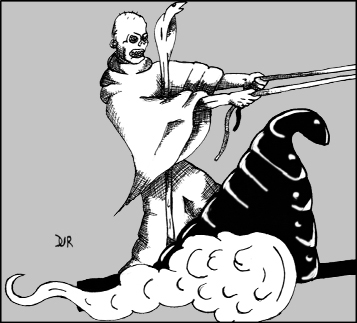 he gives control of the military. The nobles of Khoraja chafe at the idea of being led by a barbarian, but there is little choice, so the army rides out to meet Natohk’s nomads before the city is sieged.
he gives control of the military. The nobles of Khoraja chafe at the idea of being led by a barbarian, but there is little choice, so the army rides out to meet Natohk’s nomads before the city is sieged.
A titanic battle ensues, one where Conan has to face not only Natohk’s sorcery (he uses summoned mists to conceal troop movements and creates magical walls of flame), but also the arrogance and insubordination of Khoraja’s elite.
In the end, Conan’s superior tactics win the battle, but Natohk abducts Yasmela and speeds away on his demon drawn chariot with the Cimmerian in hot pursuit. The sorcerer blames the loss on his lust for the princess and intends to sacrifice her to restore his powers. Fortunately Conan arrives before he is able, hurling his sword and impaling Natohk before he can work any magic (and thus inspiring countless movies and comics where swords have been used as projectiles since).
Thugra Khotan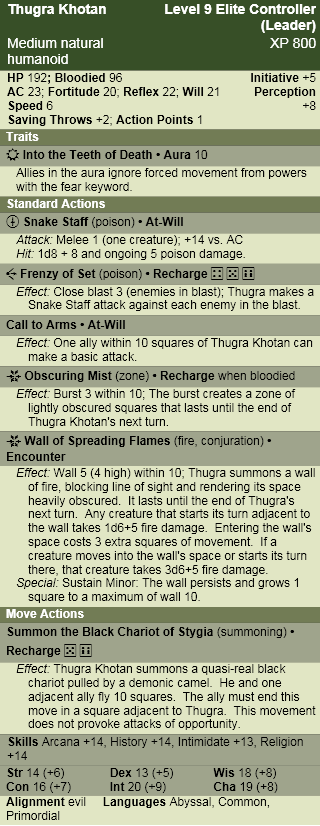
“Natohk faced the Cimmerian – inhumanly tall and lean, clad in shimmering green silk. He tossed back his veil, and Conan looked into the features he had seen depicted on the Zugite coin… Thugra Khotan’s skull-like countenance split in a mummy-like grin.” – Robert E. Howard, Black Colossus.
Lore
Nature DC 15: Thugra Khotan is an ancient Stygian sorcerer who put himself in a deep magical slumber when the city he ruled was overrun by invading barbarians. If he were to awaken, he would surely work to restore his lost glory and take revenge against the nations descended from his enemies.
Thugra Khotan in Combat
Thugra sees himself as a great general and leader of men. He enjoys using his magical abilities to control the battlefield and execute complex strategies and ambushes. His followers obey his orders without question, for they know that Thugra’s displeasure is far worse than anything their enemies can inflict.
The Stygian has no compunctions about withdrawing from a losing battle. After all, armies can be raised, servitors can be summoned, and if need be the sorcerer can seal himself away again and wait for his foes to turn to dust.
Encounters
Thugra Khotan is a master of ritual magic, especially the summoning and binding of demons, and is always accompanied by a barlgura bodyguard. In the years since his city’s downfall, the legend of his power spawned a small but dedicated cult who is now instrumental in recruiting for the sorcerer’s army. The ranks of this horde swell with a motley assortment of bandits, mercenaries, and thugs, lured by the promise of gold, glory and bloodshed.
Most of Thugra Khotan’s targets are well acquainted with the ancient sorcerer long before his minions storm a wall or batter a gate. The Stygian is a master of psychological warfare and takes great pleasure in tormenting his adversaries with sending and other magical forms of intimidation.
Notes
I admit I chose to make Thugra level 9 purely so that he could be teamed up with a barlgura lackey – just like he was in the story (well it wasn’t exactly a barlgura, it was an ape-demon, but I think the barlgura is close enough).
I wasn’t sure if I should make him undead or not since he’s described as looking like a mummy, but I don’t think he was (he was held in stasis in the ivory dome, he had mortal lusts and he was killed by a sword through the chest… I also wanted to differentiate him from a normal D&D lich). If an undead Thugra fits your game better it’s easy enough to change and doesn’t really impact anything.
Finally, the lore check uses the Nature skill simply because that’s the 4e convention for creatures with the natural origin. I think it’s much more appropriate to use the History skill instead (that’s happened before – more and more it looks to me like the knowledge skills and monster origins aren’t lining up as smoothly as I would like in 4e).
Random Encounters: Grindylow
January 18, 2011So at the suggestion of KaosEleQtric regarding my retrospective on Rifts, I’ve converted the grindylow to 4e D&D stats. The exercise reminded me of two things. First, just how much mileage you can get out of a random generator. If you’re stuck for an idea of a challenge to face your players it is definitely worth checking out the multitude of random generators online (if only for a thought experiment to get the juices flowing).
The second thing I was reminded of was just how great 4e handles monster creation. Don’t get me wrong, the system has its flaws, but when it comes to making new monsters its king (and I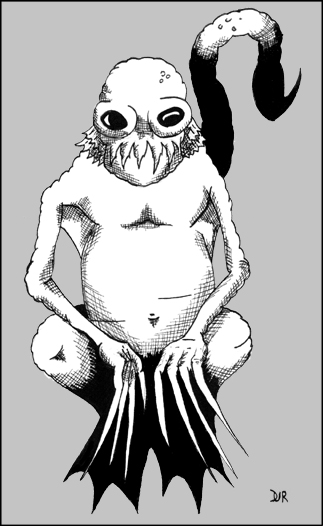 ‘m in love with the monster builder in the adventure tools). I really like the approach the rules foster to monster creation. You tackle the design from the perspective of what you want the monster to do, first and foremost (i.e. shoot eye beams, fly around, or in the case of the grindylow blind people, drag them into the water and sting them), and the end result is a monster that mechanically fulfills that vision. I love that goblins, kobolds, and orcs all feel different in combat because they are mechanically different from one another (now I just wish that the classes in 4e felt a little more different from one another). Could 3e handle any of the monsters I’ve created on this site? Of course it could, I just think it’s a lot easier in 4e (now when it comes to customizing already existing monsters 3e is definitely the king – I love the idea of adding class levels and advancing venerable monster specimens in size).
‘m in love with the monster builder in the adventure tools). I really like the approach the rules foster to monster creation. You tackle the design from the perspective of what you want the monster to do, first and foremost (i.e. shoot eye beams, fly around, or in the case of the grindylow blind people, drag them into the water and sting them), and the end result is a monster that mechanically fulfills that vision. I love that goblins, kobolds, and orcs all feel different in combat because they are mechanically different from one another (now I just wish that the classes in 4e felt a little more different from one another). Could 3e handle any of the monsters I’ve created on this site? Of course it could, I just think it’s a lot easier in 4e (now when it comes to customizing already existing monsters 3e is definitely the king – I love the idea of adding class levels and advancing venerable monster specimens in size).
With all the rumors of 5e floating around (which I think are premature personally), lets hope D&D keeps this approach to monster design.
The Grindylow
“When I was a lad my grandmother used to warn me away from the twisty bog, for that was the home of the grindylow. When I had seen my fifteenth winter I ignored her tales, as young men are wont to do, and set off into the bog with a group of ruffians in search of gold and adventure. Nary a one of them survived, all dragged beneath those black waters by the thing’s long, cruel claws, its tail cracking like a horseman’s whip. The grindylow had found us, and I’ll never forget that crying, screaming little boy I saw reflected in those hateful eyes.”
Lore
Arcana DC 15: Grindylow are malevolent fey that live in noisome bogs and other still bodies of water. They prefer to drown their prey, but are just as capable out of the water.
Arcana DC 20: The touch of pure silver burns the grindylow’s corrupt flesh, preventing it from healing. The creature’s magic aura befouls any water it stays in, earning the grindylow the enmity of Nymphs and Druids.
The Grindylow in combat
Grindylow tend to focus on weaker targets who they can easily blind and drag back to the water. They are slow witted creatures driven by an unceasing hunger for humanoid flesh and are incapable of formulating complex plans on their own.
Encounters
Grindylow are usually too cowardly to tackle a group of well armed heroes on their own, but are often pressed into service by smarter and more powerful creatures like bog and river hags. Grindylow like to hide at the fringes of combat, waiting for an opportunity to grab the wounded and drag them away from their allies.
Notes
If you’re going to use the grindylow in Gamma World add the extradimensional keyword to the monster’s description.
I ended up giving the grindylow regeneration, something the original version didn’t have, since I was emulating the only creatures in D&D with a weakness to silver: lycanthropes (which makes sense since the silver weakness in the Rifts version was emulating the Rifts version of lycanthropes).
The Tower of the Elephant
January 10, 2011Most fans of the Conan stories count The Tower of the Elephant among the best, and I can’t disagree. More important though is the obvious influence this story must have had on D&D. The premise of the adventure is classic D&D stuff: Conan hears a rumor in a bar, forms a party, and braves a monster and trap infested location for treasures which don’t turn out as he expected. And since this story predates the game by a few decades, I guess it would be more correct to say that D&D is classic Conan.
Spoiler Alert! All of these Hyborian age posts are going to be filled with spoilers. From the summary, to the monster stats they are going to ruin any surprises as to what the monster is, when they pop up in the story and how and why they are killed. You’ve been warned.
Summary
From the end of Conan’s career in The Scarlet Citadel, Howard takes us to the beginning, and a much younger and inexperienced Conan. The scene opens on the Maul, a dangerous maze-like section of an unnamed Zamorian city where city guards fear to tread and thieves rule the night. In a dimly lit drinking den Conan hears a Kothian kidnapper gossip of Yara the priest, who dwells in the elephant tower with a great magic gem known as the heart of the elephant. Conan doesn’t understand why a thief with any courage hasn’t simply taken such a treasure yet and the Kothian mocks his naiveté. Conan (even rawer than we’re used to seeing) takes offence and cuts the cur down where he stands. In the chaos following the fight, Conan strides out into the night, the target of his adventure clear.
In the gardens surrounding the tower Conan finds he is not alone in his endeavor. There is another trespasser in the garden by the name of Taurus, the self proclaimed ‘prince of thieves’. The two come to an agreement and proceed together – just in time to dispatch a group of ravenous lions that had been placed in the gardens as savage guards. Conan and Taurus scale the perilous tower and enter, but the lions are not Yara’s only defense. A monstrous spider hiding in the upper chamber poisons Taurus and almost slays the Cimmerian as well. Only Conan’s barbarian instincts see him through the fight alive.
Alone, he continues his quest for the jewel. In one of the tower’s rooms he finds a strange and monstrous creature with emerald skin and the head of an elephant. But instead of a climactic battle with this demon we are given something else. The creature is Yag-kosha, blinded and broken on the r ack – a thing to be pitied. Yag-kosha has been Yara’s prisoner for centuries, working his magic for the priest against his will, unable to escape even by taking his own life.
ack – a thing to be pitied. Yag-kosha has been Yara’s prisoner for centuries, working his magic for the priest against his will, unable to escape even by taking his own life.
The elephantine beast came from green Yag, across the cosmos, while Conan’s people were still primitive ape-men (the same Yag the seeds of Yogtha the Devil Flower were scattered from). Slowly, over vast spans of time his people died out until only Yag-kosha was left, now a shadow of his former self, indentured to the cruel tyrant Yara.
Yag-kosha sees in Conan a means for both liberation from his torture and revenge on the man who inflicted it. He instructs the barbarian to put him out of his misery by cutting out his heart and pouring the blood on the magical jewel he is linked to (the treasure Conan has risked so much to claim). The bloody task complete, Conan is to find Yara and present him with Yag-kosha’s final ‘gift’.
Not one to be squeamish about such tasks Conan obliges Yag-kosha and does as he was instructed. Taking the gem, Conan finds Yara in the haze of the yellow lotus. The dark priest is hostile and outraged at having his meditations disturbed, but goes silent when Conan delivers the heart of the elephant. The strange jewel enspells Yara, shrinking him to diminutive size before absorbing him. Inside the glass walls of the fantastic jewel Conan watches Yara trembling before a fully restored Yag-kosha.
Not sure if what he had experienced was real or not Conan steals away from the tower empty handed as the imposing tower shatters with the first rays of the sun.
Yag Starcaster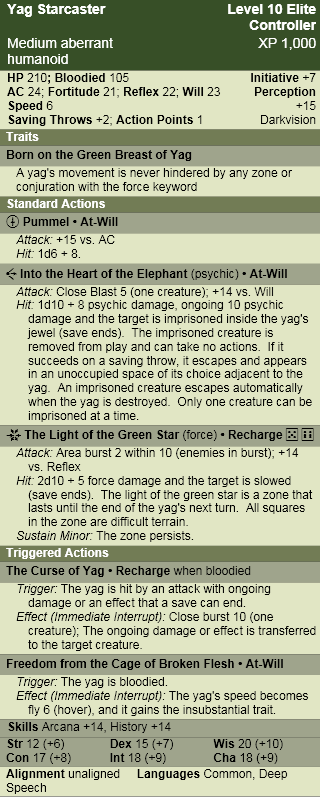
“Conan stared aghast; the image had the body of a man, naked, and green in color; but the head was one of nightmare and madness. Too large for the human body, it had no attributes of humanity. Conan stared at the wide flaring ears, the curling proboscis, one either side of which stood white tusks tipped with round golden balls.” – Robert E. Howard, the Tower of the Elephant
Lore
Dungeoneering DC 15: The Yag are a race of elephant headed, alien beings from the green star of the same name. Each Yag is bonded to a crystal, through which it works powerful magic. The Yag are extremely long lived, so much so that many consider them immortal and worship them as gods.
Dungeoneering DC 20: A Yag can die, but destroying its mortal shell merely frees the creature’s powerful, winged spirit. It is not known what caused the Yag to flee their home, but it must have been an awesome threat both physically and spiritually to send these beings across the void between the worlds.
Yag Starcaster in Combat
Yag are emotionless and methodical in combat. These creatures know that their physical forms are nothing but imperfect reflections of the spirit. For this reason a Yag does not fear death, and in many cases may even welcome it, if it furthers the creature’s goals.
Encounters
Yag are often the leaders of strange star-worshipping cults, perfecting their ancient magic and teaching it to their followers. They care little for the politics of the ‘lesser races’, but the pursuit of their alien goals often brings them and their followers into conflict with outsiders.
It is rumored that powerful star pact Warlocks can ritually bind a Yag into servitude. Such tales usually end with the Yag wreaking bloody vengeance on the Warlock who bound it.
Notes
I really liked the idea of the Yag shrinking PCs down and trapping them in its gem (what we used to call ‘minimus containment’, back in the day), so I cribbed parts of the devourer’s trap spirit ability to make it work. Since the creature is supposed to get more powerful when it dies I thought about making its freedom power work when it got to 0 hit points and adding a healing ability to it, but elite creatures have enough hit points already (especially since it gains insubstantial, it had the potential to make the combat too long). I figured making it ‘die’ when it got bloodied was probably a better call (and makes the creature die and be reborn at a better point in the combat).
I used dungeoneering for the lore check simply because that’s the 4e convention for creatures of the aberrant origin. If you’re not married to that convention then I would recommend using arcana instead, it just seems more appropriate for the astrological/alien bent of this creature than dungeoneering does.
The Scarlet Citadel – Part Two
January 2, 2011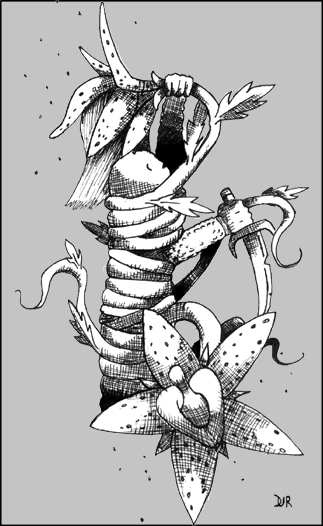 This is the second creature from Robert E. Howard’s The Scarlet Citadel. For the summary of the story as well as the creature from the pit, click here.
This is the second creature from Robert E. Howard’s The Scarlet Citadel. For the summary of the story as well as the creature from the pit, click here.
Spoiler Alert! All of these Hyborian age posts are going to be filled with spoilers. From the summary, to the monster stats they are going to ruin any surprises as to what the monster is, when they pop up in the story and how and why they are killed. You’ve been warned.
Yothga the Devil Flower
In the cold, black depths of the cosmos hangs the star known to warlocks as Yag the accursed. From here, yothga the devil flower spreads its seeds into the world to nourish itself on the thoughts and memories of intelligent creatures. It is said the seeds will only germinate in the lowest, most vile reaches of the underworld, and that as the plant grows, horrible monsters take refuge in its roots. The devil flower feeds by immobilizing its prey in its tendrils and showering them with potent sleeping spores. Once asleep yothga uses its alien flowers to siphon a victim’s thoughts and memories until only an empty soulless shell remains – a slow and ghastly process that can take a decade or longer.
Only those powerful and mad enough to make a pact with the powers of the outer dark know the secrets of cultivating one of yothga’s stalks. For these individuals the devil flower is a powerful tool of unending torture and imprisonment.
Notes
The devil flower is one of the cr eepier creatures of Tsotha-lanti’s dungeon and plays a much more pivotal role in the plot than the thing from the pit, so that alone demanded that I should create statistics for it. But as a stationary plant that didn’t eat enemies so much as imprison them, it seemed much more like a hazard than a monster. The monster summoning comes from Pelias’ comment that pulling the plant up by the roots is dangerous because Conan “…might have found things clinging to the roots against which not even your sword would prevail.” I used the ghoul and wretch of Kyuss simply because they were minions of the right level (I also felt they fit the whole ‘roots in the underworld’ thing), but any level 13 minion would do (a minion balances out the XP of the devil flower being killed with a single action, I think a full fledged creature would be too powerful). Even though the story has yothga putting people to sleep forever (until the plant is removed by an outside force), I thought that in the context of a D&D adventure it was just too deadly, so I added the option of using a healing surge to wake up. If you were running a very gritty and deadly game you could remove that option to reflect the source material more faithfully.
eepier creatures of Tsotha-lanti’s dungeon and plays a much more pivotal role in the plot than the thing from the pit, so that alone demanded that I should create statistics for it. But as a stationary plant that didn’t eat enemies so much as imprison them, it seemed much more like a hazard than a monster. The monster summoning comes from Pelias’ comment that pulling the plant up by the roots is dangerous because Conan “…might have found things clinging to the roots against which not even your sword would prevail.” I used the ghoul and wretch of Kyuss simply because they were minions of the right level (I also felt they fit the whole ‘roots in the underworld’ thing), but any level 13 minion would do (a minion balances out the XP of the devil flower being killed with a single action, I think a full fledged creature would be too powerful). Even though the story has yothga putting people to sleep forever (until the plant is removed by an outside force), I thought that in the context of a D&D adventure it was just too deadly, so I added the option of using a healing surge to wake up. If you were running a very gritty and deadly game you could remove that option to reflect the source material more faithfully.
Random Encounters: Powered Armor of the Barrier Peaks
December 24, 2010 Synchronicity (not just a great song by the Police, it’s also the most powerful weapon in Robotech) is to thank (/blame) for this post. Right around the time I read this D&D Alumni article about using the new Gamma World game to convert the classic module Expedition to the Barrier Peaks to 4e, I was exposed to the gonzo magnum opus, Booty and the Beast, over on Mr. Lizard’s gaming site. I was inspired.
Synchronicity (not just a great song by the Police, it’s also the most powerful weapon in Robotech) is to thank (/blame) for this post. Right around the time I read this D&D Alumni article about using the new Gamma World game to convert the classic module Expedition to the Barrier Peaks to 4e, I was exposed to the gonzo magnum opus, Booty and the Beast, over on Mr. Lizard’s gaming site. I was inspired.
It’s no coincidence (eh, synchronicity), that these two things should gel in my mind. Old School idol Erol Otus did the art for both products and both feature technological gadgets and weapons to incorporate into your fantasy rpg. The art and the crazy ideas in these two products are inspiring. It reminds me of a time when my mind was more open and new ideas were as easy as flipping open a comic, or turning on the TV and adding a few more ingredients to the mental stew. Sometimes it worked, sometimes it didn’t, but I was never afraid to try. Then I became a lot more serious about rpgs.
I have a confession. As cool as I thought it was (and I even owned a used 1e copy of Gamma World), I’ve never played Expedition. There’s a reason. When I was learning the ropes of DMing in public school, if I saw something I liked in one of the books, my players would find it (which led to the party’s ranger carrying a brace of magic short swords including a luck blade, nine-lives stealer, frostbrand, and more). While this was its own kind of fun, as I got older it started to lose its luster and I tried very hard at being a more serious DM. For me, when the players got their hands on machine guns and rocket launchers (putting the rpg in rpg) it was a sign that the game had gone to crazy town and the campaign was about to implode. So as much as, ‘it’s the adventure where you get to fight robots and pick up lasers’, appealed to me, it also had a giant blinking warning sign above it. Dungeons and Dragons was a tightly controlled universe that didn’t need game breaking technology floating around for the players to trip over (in high school I had a reputation as being pretty stingy with magic items). But there’s a part of me that’s very attracted to genre crossing (probably influenced by Marvel comics’ approach), which is probably why I found Rifts so refreshing in the 2e days (my love affair with Palladium is fodder for another post).
Skip ahead many years (too many) to the present. My head full of Otus Galactic Dragons and Bart Carroll issues the challenge to stat up the powered armor from Expedition. Now, I don’t own the new Gamma World, so I don’t know what an ‘omega tech’ card is, but I wanted to see if I was able to make a version of the armor that could be brought into a 4e game without destroying it. I decided to make it an artifact, since it appealed to the DM in me (artifacts are unique, easily controlled by the DM and are only in the game a limited time) and I thought the concordance mechanic was a good abstraction of the players trying to figure the thing out.
I’ve rambled on far enough without any goods to show for it, so without further ado I give you the powered armor of the Barrier Peaks.
The Powered Armor of the Barrier Peaks
Powered armor of the Barrier Peaks is appropriate for characters in the middle of the paragon tier and upward.
Goals of Powered Armor
• This artifact is not sentient and so has no goals of its own.
Roleplaying Powered Armor of the Barrier Peaks
Powered armor of the Barrier Peaks is different than other artifacts. It cannot communicate with its wearer and has no specific agenda it was created to pursue. It is the product of a foreign science even the most powerful archmagi find impossible to understand. Mastery of the item comes through experimentation and tinkering. Damaging the armor and allowing its power source to run unchecked will lead to the ruin, not just of the armor’s owner, but of everything around her.
Powered Armor of the Barrier Peaks Lore
History DC 20: Legend holds that the infamous steel clad dungeons of the Barrier Peaks were formed when the comet Warden crashed into the mountains decades ago. The winding passages of these mysterious halls are filled with exotic treasures and dangerous creatures seen no where else in the world. Perhaps the greatest treasure of all is the fabled suit of powered armor that is said to lie here, buried with the remains of the advanced race that built it.
History DC 25: Sages speculate that the alien magic used to create the powered armor of the Barrier Peaks is the same that drove the warlord Lum insane in his quest to build the gargantuan machine that bears his name.
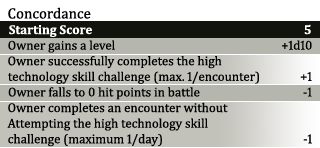
Pleased (16-20)
“Your spells are quaint superstitions next to the technological might of super-science.”
The armor’s enhancement bonus increases to +5.
Power (Daily): Fusion Blast. Standard Action. Close burst 5 (enemies in burst); Constitution vs. Reflex; Hit: 4d6 + Constitution modifier fire and force damage and ongoing 5 fire damage.
Satisfied (12-15)
“The secrets of this strange magic begin to open up to me.”
Power (Daily): Force Field. Immediate Interrupt. You can use this power when you are hit by an attack that causes damage. You gain resist all 10 + Constitution modifier until the end of your next turn.
Normal (5-11)
“I sense great power here fore those with the wisdom to use it… and great danger for the ignorant.”
The wearer is just beginning to understand the armor’s potential. Careful testing of its capabilities in combat will unlock greater functions.
Unsatisfied (1-4)
“I know I can figure this thing out. I just need more time.”
The wearer has taken the armor for granted, using its capabilities without bothering to try and understand its systems. Overloads and malfunctions are becoming more commonplace.
The armor’s enhancement bonus drops to +3.
Special: The first time each day a critical hit is scored against you, you suffer ongoing 10 lightning damage (save ends). Aftereffect: you are weakened (save ends).
Angered (0 or lower)
“What does this button do?”
The armor is severely damaged and it is only a matter of time before a 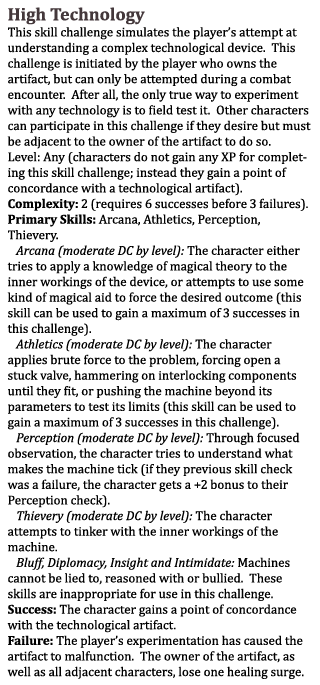 complete critical systems failure.
complete critical systems failure.
The armor’s enhancement bonus drops to +2.
Special: The first time each day you score a critical hit make the following attack as a free action: critical malfunction; close burst 4 (allies in burst); Constitution vs. Reflex; Hit: 4d6 + Constitution modifier fire and force damage.
Moving On
“The flux capacitor is completely drained.”
All machines eventually break down, burn out, or run out of fuel. Even a fusion powered suit of armor. How and when the armor moves on depends on how well the artifact’s owner can control it.
When the powered armor of the Barrier Peaks reaches its limit, if it is at least satisfied, the owner is able to power it down during a non-critical time (during an extended rest, for instance) and avoid any catastrophes. In addition, time spent breathing the nanite filtered air has had beneficial side effects. The owner gains a permanent +2 bonus on Endurance checks, and can re-roll (keeping the higher roll) any failed Endurance check made to avoid suffocation or drowning damage.
An unsatisfied or angered suit of armor goes into critical meltdown at the most inopportune time. The armor explodes and makes the following attack (which includes the owner), close burst 5 (all creatures in burst); +20 vs. Reflex; Hit: 3d10+6 fire and force damage, and the target is knocked prone; Miss: half damage.
Notes:
I wanted to use a skill challenge to increase concordance because I felt it nicely replicated the complex flow charts that Expedition used to ‘simulate ignorance’ in the proper use of technological items. Players could experiment with these items during downtime, but the charts had some dangerous outcomes so there was real risk involved (losing charges, getting hurt or the item blowing up). Since my version of this item was an artifact and didn’t have charges, and given how healing and extended rests worked in 4e, that meant I would need to tweak things in order to preserve that element of danger. I felt a simple solution would be to make a skill challenge that could only be undertaken during a combat encounter. That way, if the players want to increase their understanding of the armor they have to be willing to sacrifice some of their combat actions (not to mention potentially losing a healing surge).
The picture is a twenty-one gun (or maser) salute to Erol Otus’ illustration of the power armor in Expedition. Somehow the 1970’s science fiction imagery of power armor just seems to fit D&D better than the anime aesthetic (although I do picture Gigantor as the mighty servant of Leuk-O).

